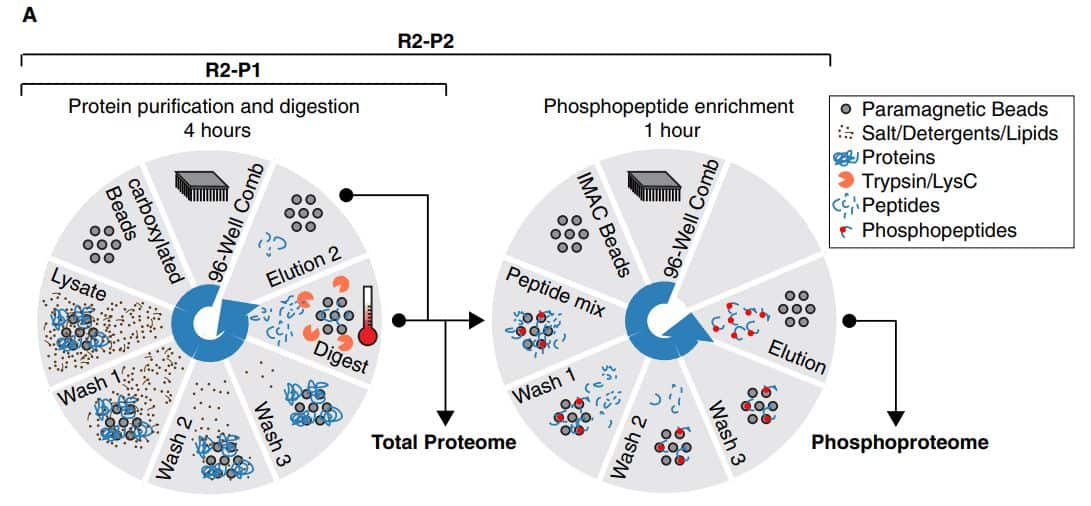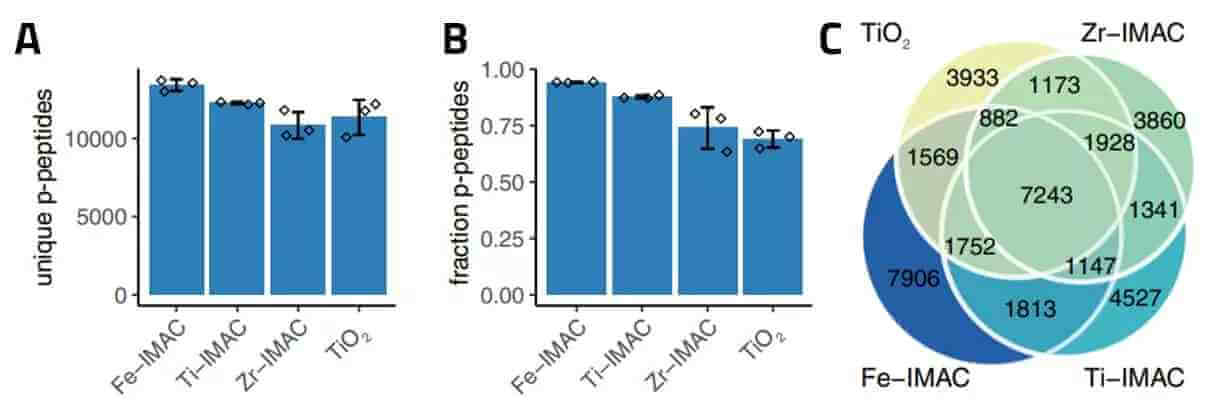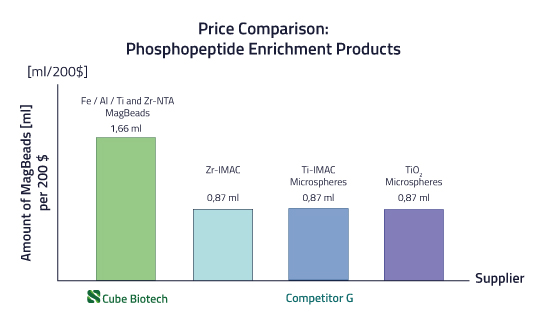PureCube Al-NTA MagBeads
Order number: 31501-Al
Description
PureCube Al-NTA Magbeads / Magnetic beads were developed for the enrichment of phosphorylated proteins. They can also be used for the purification of his tagged proteins as a secondary function. The affinity matrix is based on 6% cross-linked agarose that was magnetized. The bead ligand is Al-NTA and the particle diameter is 30 µm. They are very homogeneous in size, yielding in a high degree of reproducibility. The phosphopeptide enrichment with Cube Biotech MagBeads can be automated as it has already been proven in this paper.
As an alternative we also offer PureCube Fe-NTA Agarose resin and said resin pre-packed in cartridges/columns.
As an alternative we also offer PureCube Fe-NTA Agarose resin and said resin pre-packed in cartridges/columns.
| Feature | |
|---|---|
| Usage | Enrichment of phosphopeptides |
| Specificity | Affinity to phosphorylated biomolecules |
| Bead ligand | Al-NTA |
| Bead size | 20-40 µm (30 µm average) |
| Filling quantity | 25% (v/v) suspension (20 µl suspension corresponds to 5 µl magnetic beads) |
| Storage Buffer | 20 mM sodium acetate with 20% ethanol, pH 6.6 |
| Metal ion capacity | >12 µeqv Al3+/ml |
| Compatible reagents | 100% methanol, 100% ethanol, 8 M urea, 6 M guanidinium hydrochloride, 30% (v/v) acetonitrile, pH 2-4 |
| Storage | 2-8 °C. Short-term: in neutral buffer (e.g. 50 mM phosphate, pH 7.0) or for proteomics in equilibration buffer (50% ACN, 50% MeOH, 0.01% acetic acid); Long-term: in neutral buffer with 20% ethano |
| Shipping | Room temperature |
Lab Results
Automatic Phosphoproteomics for high-throughput projects
Fe-NTA magnetic beads by Cube Biotech have been proven to increase the speed of a high throughput experiment drastically. Leutert et al. (2019) presented the application of PureCube Fe-NTA MagBeads in a procedure that they named R2-P2, which is short for Rapid-Robotic PhosphoProteomics. They used a KingFisherTM Flex for their robotic runs to fully automize the phosphopeptide enrichment process.
Fe-NTA magnetic beads by Cube Biotech have been proven to increase the speed of a high throughput experiment drastically. Leutert et al. (2019) presented the application of PureCube Fe-NTA MagBeads in a procedure that they named R2-P2, which is short for Rapid-Robotic PhosphoProteomics. They used a KingFisherTM Flex for their robotic runs to fully automize the phosphopeptide enrichment process.

Source: Leutert et al. (2019)
Superiority over other phosphopeptide enrichment methods
Leutert et al. compared three different types of IMAC beads (including our PureCube Fe-NTA) and TiO2 microspheres. As it can be seen in figure 2 our PureCube Fe-NTA magnetic beads presented themselves to be the best option for phosphopeptide enrichment. With our Fe-NTA MagBeads the most unique phosphopeptides (Fig. 2 A and C) were enriched with the highest efficiency (Figure 2 B).
Leutert et al. compared three different types of IMAC beads (including our PureCube Fe-NTA) and TiO2 microspheres. As it can be seen in figure 2 our PureCube Fe-NTA magnetic beads presented themselves to be the best option for phosphopeptide enrichment. With our Fe-NTA MagBeads the most unique phosphopeptides (Fig. 2 A and C) were enriched with the highest efficiency (Figure 2 B).

Source: Leutert et al. (2019)
The best product for the best prize
Analyzing and comparing products from various manufacturers and suppliers can often prove to be a laborious task. The presence of varying concentrations and volumes across different suppliers can lead to confusion when trying to identify the optimal cost-benefit ratio. Recognizing these challenges, Cube Biotech has undertaken the effort to compile a comprehensive overview of prices for the frequently utilized phosphopeptide enrichment products (see Fig. 2 C). Our intention is to provide researchers with a clearer understanding of the prevailing pricing landscape in the market, facilitating informed decision-making.
Analyzing and comparing products from various manufacturers and suppliers can often prove to be a laborious task. The presence of varying concentrations and volumes across different suppliers can lead to confusion when trying to identify the optimal cost-benefit ratio. Recognizing these challenges, Cube Biotech has undertaken the effort to compile a comprehensive overview of prices for the frequently utilized phosphopeptide enrichment products (see Fig. 2 C). Our intention is to provide researchers with a clearer understanding of the prevailing pricing landscape in the market, facilitating informed decision-making.

FAQ
Can I get the datasheet for the Al-NTA MagBeads?
What can I do with Al-NTA beads?
They are meant to be used as the matrix to bind and thus enrich phophopeptides.
How does the phosphopeptide enrichment process work?
Can I enrich all phosphopeptides using Al-NTA?
No, this is not possible. Not all phosphopeptides bind to Al-NTA beads. As shown in figure 2 multiples bead types must be used to cover all phosphopeptides off a cell. Because of that we also offer Fe-, Zr- and Ti-NTA beads.



